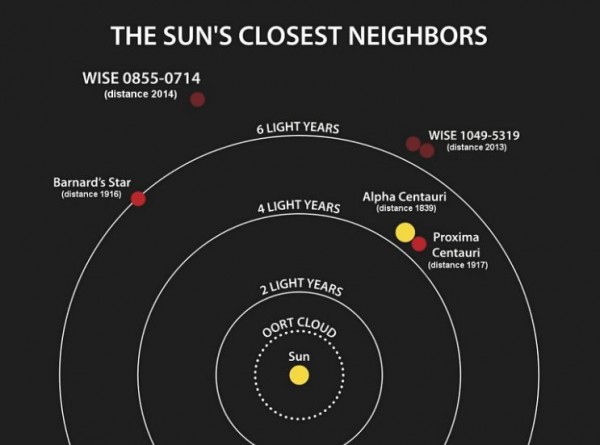Earth-like Exoplanet ‘Proxima b’ Found Orbiting the Star Closest to Earth
| Arthur Dominic Villasanta | | Aug 24, 2016 10:36 PM EDT |
(Photo : NASA) Our closest interstellar neighbors.
An international team of astronomers has confirmed the discovery of "Proxima b," the closest potentially habitable exoplanet ever detected outside our solar system.
Located only 4.2 light years away or 25 trillion miles, Proxima b is so close it's possible for a space probe to reach this rocky, extremely hot exoplanet orbiting the star Proxima Centauri before the end of this century. Proxima Centauri is the star closest to our sun.
Like Us on Facebook
Scientists hope for a "robotic exploration in the coming centuries."
"The good news is that it is so close," study author Ansgar Reiners said. "It is not only nice for having it in our neighborhood, but it's a dream come true for astronomers if we think about follow-up observation."
The international team of astronomers that announced the discovery haven't seen Proxima b but confirmed its existence indirectly using telescopes to identify and precisely calculate the gravitational pull it had on its star, a proven method in exoplanet-hunting.
"We hit the jackpot here," said Guillem Anglada-Escude , an astrophysicist at the Queen Mary University of London and lead author of a study on the discovery.
He said the planet is "more or less what we have on Earth."
Proxima b lies within the Goldilocks Zone or the habitable zone where water, and therefore life, might exist. In the case of Proxima b, however, that habitable zone is quite close to Proxima Centauri, a low-mass red dwarf star known as an M-class dwarf.
Proxima b is only 4.6 million miles from Proxima Centauri, or one-twentieth of the distance between Earth and the sun. This means Proxima b is even closer than Mercury is to our sun.
Proxima b, however, isn't a hellishly hot world because of this since its red dwarf sun is much cooler and fainter than our sun. This also means Proxima b has a temperature likely suitable for liquid water to exist on the surface without evaporating.
Proxima b doesn't rotate, a factor that makes life likely on the dark and cooler side of the planet. The side perpetually facing its sun, however, is bombarded with intense ultraviolet and X-ray flares 100 times the intensity of what Earth receives from the sun.
Astronomers said the close proximity of Proxima b to its sun likely means it has a bright orange sky with no blue, so the skies in this exoplanet look like it in an eternal sunset. Proxima b orbits its star so quickly its year is only 11.2 days long.
Scientists surmise Proxima b is a rocky, terrestrial planet with a surface 1.3 times the size of Earth. Researchers believe that if Proxima b has an atmosphere, the surface temperature might be between 86 to 104 degrees Fahrenheit.
Without an atmosphere, it could be -22 to -40 degrees Fahrenheit. Earth would be -4 degrees if it didn't have an atmosphere.
"It's not only the closest terrestrial planet found, it's probably the closest planet outside our solar system that will ever be found because there is no star closer to the solar system than this one," said Anglada-Escudé.
Researcher Pedro Amado noted "the only thing you can hope to find between that is Planet Nine, but that would a solar system object or a brown dwarf that hasn't been discovered."
TagsProxima b, Proxima Centauri, exoplanet, Ansgar Reiners, Goldilocks Zone, red dwarf star
©2015 Chinatopix All rights reserved. Do not reproduce without permission
EDITOR'S PICKS
-

Did the Trump administration just announce plans for a trade war with ‘hostile’ China and Russia?
-

US Senate passes Taiwan travel bill slammed by China
-

As Yan Sihong’s family grieves, here are other Chinese students who went missing abroad. Some have never been found
-

Beijing blasts Western critics who ‘smear China’ with the term sharp power
-

China Envoy Seeks to Defuse Tensions With U.S. as a Trade War Brews
-

Singapore's Deputy PM Provides Bitcoin Vote of Confidence Amid China's Blanket Bans
-

China warns investors over risks in overseas virtual currency trading
-

Chinese government most trustworthy: survey
-

Kashima Antlers On Course For Back-To-Back Titles
MOST POPULAR
LATEST NEWS
Zhou Yongkang: China's Former Security Chief Sentenced to Life in Prison

China's former Chief of the Ministry of Public Security, Zhou Yongkang, has been given a life sentence after he was found guilty of abusing his office, bribery and deliberately ... Full Article
TRENDING STORY

China Pork Prices Expected to Stabilize As The Supplies Recover

Elephone P9000 Smartphone is now on Sale on Amazon India

There's a Big Chance Cliffhangers Won't Still Be Resolved When Grey's Anatomy Season 13 Returns

Supreme Court Ruled on Samsung vs Apple Dispute for Patent Infringement

Microsoft Surface Pro 5 Rumors and Release Date: What is the Latest?














